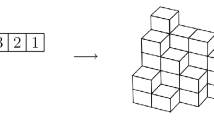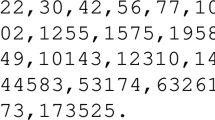Abstract
In the 1970s, Nicolas proved that the partition function p(n) is log-concave for \( n > 25\). In Heim et al. (Ann Comb 27(1):87–108, 2023), a precise conjecture on the log-concavity for the plane partition function \({{\textrm{pp}}}(n)\) for \(n >11\) was stated. This was recently proven by Ono, Pujahari, and Rolen. In this paper, we provide a general picture. We associate to double sequences \(\{g_d(n)\}_{d,n}\) with \(g_d(1)=1\) and
polynomials \(\{P_n^{g_d}(x)\}_{d,n}\) given by
We recover \( p(n)= P_n^{\sigma _1}(1)\) and \({{\textrm{pp}}}\left( n\right) = P_n^{\sigma _2}(1)\), where \(\sigma _d (n):= \sum _{\ell \mid n} \ell ^d\) and \(f_d(n)= n^{d-1}\). Let \(n \ge 6\). Then the sequence \(\{P_n^{\sigma _d}(1)\}_d\) is log-concave for almost all d if and only if n is divisible by 3. Let \({{\textrm{id}}}(n)=n\). Then \(P_n^{{{\textrm{id}}}}(x) = \frac{x}{n} L_{n-1}^{(1)}(-x)\), where \(L_{n}^{\left( \alpha \right) }\left( x\right) \) denotes the \(\alpha \)-associated Laguerre polynomial. In this paper, we investigate Turán inequalities
Let \(n \ge 6\) and \(0 \le x < 2 - \frac{12}{n+4}\). Then n is divisible by 3 if and only if \(\Delta _{n}^{g_d}(x) \ge 0\) for almost all d. Let \(n \ge 6\) and \(n \not \equiv 2 \pmod {3}\). Then the condition on x can be reduced to \(x \ge 0\). We determine explicit bounds. As an analogue to Nicolas’ result, we have for \(g_1= {{\textrm{id}}}\) that \(\Delta _{n}^{{{\textrm{id}}}}(x) \ge 0\) for all \(x \ge 0 \) and all n.
Similar content being viewed by others
Avoid common mistakes on your manuscript.
1 Introduction and main results
In this paper, we study Turán inequalities \(p_n(x)^2 -p_{n-1}(x) \, p_{n+1}(x) \ge 0\) for families of polynomials \(\{p_n(x)\}_n\) attached to arithmetic functions.
Our work is motivated by a recent result by Ono et al. [8, 13]. Ono et al. proved the log-concavity conjecture ([9], Conjecture 1) for plane partitions \({{\textrm{pp}}}\left( n\right) \) for \(n >11\). Twenty-four years ago, Nicolas [12] had already proved the log-concavity property for the partition numbers p(n) for \(n >25\). This result was reproved by DeSalvo and Pak [5]. For an introduction to partition numbers and plane partition numbers, we refer to Andrews’ book [1]. Further, to study the concept of log-concavity and related topics, Brenti [2] and Stanley [14, 15] are suitable references.
This paper is also a significant generalization of our previous result in [8]. Let \(a_d(n):= \frac{1}{n} \sum _{k=1}^n \left( \sum _{\ell \vert k} \ell ^d \right) \, a_d(n-k)\), with \(a_d(0)=1\). Let \(n \ge 6\) be fixed. Then the sequence \(\{a_d(n)\}_n\) is log-concave at n for almost all \( d\in {\mathbb {N}}\) if and only if \(n \equiv 0 \pmod {3}\). Note that \(p(n)= a_1(n)\) and \({{\textrm{pp}}}(n)= a_2(n)\). The quantities p(n) and \({{\textrm{pp}}}\left( n\right) \) are induced by certain arithmetic functions. This leads to the following generalization.
Definition
Let \({\mathbb {D}}\) be the set of all double sequences \(\{g_d(n)\}_{d,n \ge 1}\) with normalization \(g_d(1)=1\), such that \(\sum _{n=1}^{\infty } g_d(n) \, q^{n-1}\) is regular at \(q=0\) with radius of convergence R, and
for all d and n.
We investigate sequences of polynomials \(\{P_n^{g_d}(x)\}_n\), defined by the recurrence relation:
We have the generating series
where \( n \, f_d(n) = \sum _{\ell \mid n } \mu (\ell ) \, g_d(n/ \ell )\) with \(\mu \) the Moebius function. Examples for \(g_d(n)\) are \(\{\sigma _d(n)\}\) and \(\{\psi _d(n)\}\), where \(\sigma _d(n)= \sum _{\ell \mid n} \ell ^d\) and \(\psi _d(n)= n^d\). Turán’s inequality of \(\{P_n^{g_d}(x)\}\) at n for a subset of \({\mathbb {R}}\) is defined by
Let \(x_0\) be fixed, we call \(P_n^{g_d}(x_0)\) log-concave at n if \(\Delta _{n}^{g_d}(x_0)\ge 0\).
We note that the partition function and the plane partition function satisfy \(p(n)= P_{n}^{\sigma _1}(1)\) and \({{\textrm{pp}}}\left( n\right) = P_n^{\sigma _2}(1)\). Let \(E^{g_d}\) be the set of all \(n \in {\mathbb {N}}\) with \(\Delta _{n}^{g_d}(1)<0\), denoted as strictly log-convex.
Nicolas [12] proved that the partition function p(n) is log-concave for almost all n. The set of exceptions is given by \(E^{\sigma _{1}}= \left\{ 2k +1 \, : \, 0 \le k \le 12\right\} \). Ono et al. [13] proved that \(E^{\sigma _2}= \{1,3,5,7,9,11\}\). Numerical investigations [8] for \(n \le 10^5\) indicate that \(E^{\sigma _3}= \{1,3,5,7\}\), \(E^{\sigma _4}= E^{\sigma _5}=\{1,5\}\). Surprisingly, \(E^{\sigma _{20}}\) has at least 10 elements. We believe that the general and clean patterns associated to double sequences in \( {\mathbb {D}}\) are displayed by \(g_d(n)= \psi _d(n)\) (see Table 1).
In our main result, we capture the impact of the residue of n divided by 3 and the range of the argument of the \(\Delta _n^{g_d}(x)\).
Theorem 1.1
Let \(\{g_d(n)\}\) be a double sequence in \({\mathbb {D}}\). Let \(n \ge 6\). Moreover let
be the Turán inequality.
-
(a)
Let \(0 \le x < 2- \frac{12}{n+4}\). Then (1.1) holds true for almost all d if and only if n is divisible by 3.
-
(b)
Let \(n \not \equiv 2 \pmod {3}\) and \(x \ge 0\). Then (1.1) holds true for almost all d if and only if n is divisible by 3.
The case \(g_{d}\left( n\right) = \sigma _{d} \left( n\right) \) and \(x=1\) leads to the results obtained in [8], Theorem 1.2 and Theorem 1.3. An explicit analysis of the bounds obtained in the proof of Theorem 1.1 leads to the following:
Theorem 1.2
Let \(\left\{ g_{d} \left( n\right) \right\} \) be a double sequence in \( {\mathbb {D}}\). Let \(n \ge 3\) and \(n \ne 5\). Let R be the radius of convergence of \(\sum _{n=1}^{\infty } g_1(n) \, \frac{q^n}{n}\). For each x, let r(x) be chosen with \( 0< r(x) < R\) and \(P_n^{g_{1} }(x) \le r(x)^{-n}\) for all n. Then we have the following properties.
-
(i)
Let \(n \equiv 0 \pmod {3}\) and \(x >0\). Then \(\Delta _n^{g_d}(x) \ge 0\) for \(d \ge d_{0}\left( n,x\right) \), where
$$\begin{aligned} d_{0}\left( n,x\right) =1+\frac{2n}{3\ln \left( 9/8\right) } \left( \ln \left( n/3\right) - \ln \left( x\right) -3\ln \left( r(x) \right) \right) . \end{aligned}$$ -
(ii)
Let \(n \equiv 1 \pmod {3}\) and \(x >0\). Then \(\Delta _n^{g_d}(x) < 0\) for \(d \ge d_{0 }\left( n,x\right) \), where
$$\begin{aligned} d_{0} \left( n,x\right) =1+\frac{2n}{3\ln \left( 9/8\right) } \left( \ln \left( \frac{n-1}{3}\right) -\frac{ 2n+1}{ 2n} \ln \left( x\right) -3\ln \left( r(x) \right) \right) . \end{aligned}$$ -
(iii)
Let \(n \equiv 2 \pmod {3}\) and \(0<x<2-\frac{12}{n+4}\). Then \(\Delta _n^{g_d}(x) < 0\) for \(d \ge d_{0 }\left( n,x\right) \), where
$$\begin{aligned} d_{0} \left( n,x\right){} & {} = 1+\frac{1}{ \ln \left( 9/8\right) }\left( -\min \left\{ 0,\ln \left( \frac{n-2}{3n+3} \left( \frac{1}{x}+\frac{1}{2}\right) -\frac{1}{3}\right) \right\} \right. \\{} & {} \left. \quad + \, \frac{n-2}{3}\ln \left( \frac{n-2}{3}\right) - \frac{n+1}{3}\ln \left( x\right) -n\ln \left( r(x) \right) \right) . \end{aligned}$$
Remark
-
(a)
The positive real number r(x) always exists due to Cauchy–Hadamard’s theorem.
-
(b)
Let \(g_d(n)= n^d\). Then \(\Delta _4^{g_5}(x)\) has sign changes for positive real x, since there are two positive, real zeros \(\alpha _1 < \alpha _2\).
2 Records
Let \(g_d(n)= \sigma _d(n)\). Then for \(d=1\) and \(d=2\), complete results for the log-concavity \(\Delta _n^{g_d}(1) \ge 0\), including the explicit \(E^{\sigma _d}\), are provided by Nicolas [12] and Ono–Pujahari–Rolen [13]. For \(n\le 10^{5}\) and \(d \le 8\), further results have been obtained by Heim–Neuhauser [8].
Let \(g_d(n)= \psi _d(n)\). In Table 2, we have displayed the results for \(1 \le d \le 9\). In this paper, we prove the analogue to Nicolas’ result and give some numerical evidence for the case \(d=2\), which is for \(\sigma _{2}\left( n \right) \) the log-concavity for plane partitions.
More generally, let \(\{g_d(n)\}\) be a double sequence in \( {\mathbb {D}}\). Then \(\Delta _1^{g_d}(1)\) is always negative, since
and \(g_d(2) \ge 2\). This explains the results for \(n=1\) at \(x=1\).
For \(x >0\), we have \(\Delta _{1}^{\psi _{d}}\left( x\right) \ge 0 \) if and only if \(x \ge 2^d\). Let \(n \ge 2\). Table 3 records our results for Turán inequalities for small d.
In the case \(d=5\), a new feature appears (see Fig. 2). Let \(3 \le n \le 100\) then there are exactly two simple positive zeros. Their position implies \(\Delta _3^{\psi _5}(1)>0\), \(\Delta _4^{\psi _5}(1)<0\), and \(\Delta _n^{\psi _5}(1)>0\) for \( 5 \le n \le 100\). We expect that this holds true for all \(n \ge 5\).
3 Basic formulas
Let g be a normalized arithmetic function. Let
Then \(P_n^g(x)\) are polynomials of degree n. We refer to [10] for a detailed study of these polynomials. For example \(P_1^g(x)=x\) and \(P_2^g(x) = x/2 \, (x +g(2))\).
3.1 Coefficients of \(P_n^g(x)\)
Let
Then \(A_{0,0}^g=1\). Let \(n \ge 1\) then \(A_{n,0}^g=0\), \(A_{n,1}^g= g(n)\, / \, n\) and \(A_{n,n}^g = 1 \, / \, n!\). We also have [10] for \(1 \le m <n\) and \(n-m=1,2,3\):
Lemma 3.1
Let g be a normalized arithmetic function and
Then \(\Delta _1^g(x) = \frac{x}{2} \left( x-g(2) \right) \) and \(\Delta _2^g(x) = \frac{x^2}{12} \left( x^2 + 3 \, g(2)^2 - 4 \, g(3)\right) \). Further,
This follows from the explicit form of the polynomials. We have
3.2 Properties of \(\Delta _n^g(x)\)
Let us establish the following notation:
In contrast to \(P_n^g(x)\), the coefficients of \(\Delta _n^g(x)\) are not always non-negative in general. Nevertheless, we have \(\Delta _n^g(0)=0\) and the important asymptotic property
This follows from \(D_{n,2n}^g = \frac{1}{(n!)^2 \, (n+1)}\). Let \(n \ge 2\). We can always factor out \(x^2\) and still have polynomials, since \(D_{n,0}^g = D_{n,1}^g =0\). The new constant term is given by \(D_{n,2}^g\), which does not need to be non-negative:
3.3 Special cases
Let \(\{g_d(n)\}\) be a double sequence in \( {\mathbb {D}}\). We have \(\Delta _1^{g_d}(x) = x \, (x-g_d(2))/2\). Thus, \(\Delta _1^{g_d}(x) = 0\) if \(x=0\) or \(x= g_d(2)\). Thus, \(\Delta _1^{g_d}(x)>0\) if and only if \(x \not \in [0, g_d(2)]\). This implies that \(\Delta _1^{g_d}(x)<0\) for \(x\in \left( 0,g_{d}\left( 2\right) \right) \) and all \(d \in {\mathbb {N}}\). The case \(n=2\) is still directly accessible. We have \(\Delta _2^{g_d}(x) = 0\) if \(x=0\) or \(x^2= 4\, g_d(3)-3 \,\left( g_{d}\left( 2\right) \right) ^2\). We consider \(4\, g_d(3)-3 \,\left( g_{d}\left( 2\right) \right) ^2 \ge 0\) and \(x \ne 0\). Let \(g_{d} = \psi _{d} \) or \(g_{d}=\sigma _{d}\). Then \(\Delta _2^{\psi _d}(x) >0\) for \(d \in {\mathbb {N}}\), especially \(\Delta _2^{\psi _1}(x) =x^4/12\).
4 Proof of Theorem 1.1
Our strategy is to utilize the well-known formula ([11, Sect. 4.7]):
4.1 Lower and upper bounds
In [8, Sect. 3], we have obtained lower and upper bounds for \(P_n^{\sigma _d}(1)\). The invented proof method can be generalized in a straightforward manner to obtain the following result for all double sequences in \( {\mathbb {D}}\) and the associated polynomials for \(x >0 \).
Proposition 4.1
Let the double sequence \(\{g_d(n)\}_{d,n \in {\mathbb {N}}}\) be an element of \( {\mathbb {D}}\). Let \(n \ge 3\) and \(x >0\). Then we have for all \(d\ge 1\) the following upper and lower bounds.
Let \(n \equiv 0 \pmod {3}\) and \(n^{\prime }:= n/3\). Then
Further, let \(n \equiv 1 \pmod {3}\) and \(n^{\prime }:= (n-4)/3\). Then
Further, let \(n \equiv 2 \pmod {3}\) and \(n' := (n-2)/3\). Then
Additionally, let \(n \equiv 2 \pmod {3}\) and \(n \ge 8\). Let \(n':= (n-2)/3\). Then
4.2 Proof of Theorem 1.1
For \(x=0\), the inequality (1.1) holds certainly true. Therefore, let \(x>0\). We apply Proposition 4.1.
4.2.1 The case \(n\equiv 0 \pmod {3}\)
In the first step, we apply Proposition 4.1. This leads to
We choose \(r(x)>0\), such that \(P_n^{g_1}(x) \le r(x)^{-n}\) for all n. Let
Then \(\left\{ P_{n}^{g_{d}}\left( x\right) \right\} _{n}\) is strictly log-concave at n for \(d \ge d_0\), since
4.2.2 The case \(n\equiv 1 \pmod {3}\)
In the first step, we apply Proposition 4.1. This leads to
We choose \(r(x)>0\), such that \(P_n^{g_1}(x) \le r(x)^{-n}\) for all n. Let
Then the sequence \(\left\{ P_{n}^{g_{d}}\left( x\right) \right\} _{n}\) is strictly log-convex at n for \(d \ge d_{0 }\), since
4.2.3 The case \(n\equiv 2 \pmod {3}\)
This final case involves some additional considerations. Again we first apply Proposition 4.1 and obtain
The last inequality can only be not larger than zero if \(0<x<2-\frac{12}{n+4}\). We choose \(r(x)>0\) such that \(P_n^{g_1}(x) \le r(x)^{-n}\) for all n. Then
for
Let \(d_{0} =d_{0} \left( n,x\right) \) be defined by
Then the sequence \(\{P_n^{g_d}(x)\}_d\) is strictly log-convex for all \(d \ge d_{0} \).
5 Turán inequalities
Let \(\{g_d(n)\}\) be a double sequence in \( {\mathbb {D}}\). We are interested in finding the set of positive real numbers, such that \(\Delta _n^{g_d}(x) \ge 0\), with special emphasis on the behavior at \(x=1\).
In [7], a conjecture for \(\Delta _n^{\sigma _1}(x)\) was stated, which generalized a conjecture of Chern–Fu–Tang [4] related to integers \(x \ge 2\). The Chern–Fu–Tang conjecture was proven by Bringmann et al. [3]. Recently, a second conjecture [9] was proposed for \(\Delta _n^{\sigma _2}(x)\). We have shown for \(x=1\), the case of plane partitions, that \(\Delta _n^{\sigma _2}(1)>0\) for almost all n. Finally, Ono et al. [13] have proven that \(\Delta _n^{\sigma _2}(1)>0\) for all \(n \ge 12\). We now show that \(\Delta _{n}^{\psi _{1}}\left( x\right) \ge 0\) for all \(x \in {\mathbb {R}}\). This is the first case where a full result on Turán inequalities is obtained for a double sequence in \( {\mathbb {D}}\) with d fixed.
5.1 \(\Delta _n^{\psi _1}(x) \ge 0\)
We have \(\psi _1(n)=1\). The polynomials \(P_n^{\psi _1}(x)\) had been studied in [6] and had been found intimately related with the \(\alpha \)-associated Laguerre polynomials. We have \(P_n^{\psi _1}(x)= \frac{x}{n} L_{n-1}^{(1)}(-x)\), where
The Laguerre polynomials of degree n are given by \(L_n(x)= L_n^{(0)}(x)\). It is known that \(\alpha \)-associated Laguerre polynomials for \(\alpha \ge 0\) satisfy:
These Turán inequalities are not sufficient to prove \(\Delta _n^{\psi _1}(x) \ge 0\). We have to show for all \(x \in {\mathbb {R}}\) that
Szegő [16] proved in 1948, that \(L_n^{(\alpha )}(x) / L_n^{(\alpha )}(0)\) satisfies Turán inequalities, where \( L_n^{(1)}(0)= n+1\). This proves our claim.
5.2 Challenges
We propose three open questions.
5.2.1 Log-concavity of partition and plane partition numbers
Reprove the results of Nicolas [12] and Ono et al. [13] on the log-concavity of the partition numbers and the plane partition numbers utilizing the zero distribution of the polynomials \(\left\{ P_{n}^{\sigma _{d}}\left( x\right) \right\} \) for \(d=1\) and \(d=2\).
5.2.2 Turán inequalities \(\Delta _{n}^{\psi _d}(x) \ge 0\)
Based on our numerical investigations on the zeros of \(\Delta _n^{\psi _d}(x)\), we believe that it is very likely for \(2 \le d \le 4\) that \(\Delta _n^{\psi _d}(x) \ge 0\) for \(n \ge 2\) and \(x \in {\mathbb {R}}\). Prove this observation.
5.2.3 The case \(n \equiv 0 \pmod {3}\)
The following problem was presented at the Conference: 100 Years of Mock Theta Functions at Vanderbilt University in 2022 (organized by Rolen and Wagner). Prove that \(\Delta _n^{\psi _d}\left( x\right) \ge 0\) for all \(n \equiv 0 \pmod {3}\) and all \(d \in {\mathbb {N}}\).
References
Andrews, G.E.: The Theory of Partitions. Cambridge University Press, Cambridge (1998)
Brenti, F.: Unimodal, Log-Concave and Pólya Frequency Sequences in Combinatorics, vol. 413. American Mathematical Society, Berlin (1989)
Bringmann, K., Kane, B., Rolen, L., Tripp, Z.: Fractional partitions and conjectures of Chern–Fu–Tang and Heim–Neuhauser. Trans. Am. Math. Soc. Ser. B 8(21), 615–634 (2021)
Chern, S., Fu, S., Tang, D.: Some inequalities for \(k\)-colored partition functions. Ramanujan J. 46, 713–725 (2018)
DeSalvo, S., Pak, I.: Log-concavity of the partition function. Ramanujan J. 38, 61–73 (2015)
Heim, B., Luca, F., Neuhauser, M.: Recurrence relations for polynomials obtained by arithmetic functions. Int. J. Numb. Theory 15(6), 1291–1303 (2019)
Heim, B., Neuhauser, M.: Polynomization of the Chern–Fu–Tang conjecture. Res. Numb. Theory 7, 26 (2021)
Heim, B., Neuhauser, M.: Log-concavity of infinite product generating functions. Res. Numb. Theory 8, 53 (2022)
Heim, B., Neuhauser, M., Tröger, R.: Inequalities for plane partitions. Ann. Comb. 27(1), 87–108 (2023)
Heim, B., Neuhauser, M.: Formulas for coefficients of polynomials assigned to arithmetic functions. http://arxiv.org/abs/2010.07890v2
Kostant, B.: Powers of the Euler product and commutative subalgebras of a complex simple Lie algebra. Invent. Math. 158, 181–226 (2004)
Nicolas, J.-L.: Sur les entiers \(N\) pour lesquels il y a beaucoup des groupes abéliens d’ordre \(N\). Ann. Inst. Fourier 28(4), 1–16 (1978)
Ono, K., Pujahari, S., Rolen, L.: Turán inequalities for the plane partition function. Adv. Math. 409, 108692 (2022)
Stanley, R.: Log-concave and unimodal sequences in algebra, combinatorics, and geometry. In: Capobianco, M.F., Guan, M.G., Hsu, D.F., Tian, F. (eds.) Graph Theory and Its Applications: East and West. Proceedings of the First China–USA International Conference, Held in Jinan, China, June 9–20, 1986. Ann. New York Acad. Sci., Vol. 576. New York Acad. Sci., New York, pp. 500–535 (1989)
Stanley, R.: Enumerative Combinatorics. Vol. 2. With a Foreword by Gian-Carlo Rota and Appendix 1 by Sergey Fomin, Cambridge Studies in Advanced Mathematics, vol. 62. Cambridge University Press, Cambridge (1999)
Szegő, G.: On an inequality of P. Turán concerning Legendre polynomials. Bull. Am. Math. Soc. 54, 401–405 (1948)
Funding
Open Access funding enabled and organized by Projekt DEAL.
Author information
Authors and Affiliations
Corresponding author
Additional information
Publisher's Note
Springer Nature remains neutral with regard to jurisdictional claims in published maps and institutional affiliations.
Rights and permissions
Open Access This article is licensed under a Creative Commons Attribution 4.0 International License, which permits use, sharing, adaptation, distribution and reproduction in any medium or format, as long as you give appropriate credit to the original author(s) and the source, provide a link to the Creative Commons licence, and indicate if changes were made. The images or other third party material in this article are included in the article’s Creative Commons licence, unless indicated otherwise in a credit line to the material. If material is not included in the article’s Creative Commons licence and your intended use is not permitted by statutory regulation or exceeds the permitted use, you will need to obtain permission directly from the copyright holder. To view a copy of this licence, visit http://creativecommons.org/licenses/by/4.0/.
About this article
Cite this article
Heim, B., Neuhauser, M. Turán inequalities for infinite product generating functions. Ramanujan J (2023). https://doi.org/10.1007/s11139-023-00763-9
Received:
Accepted:
Published:
DOI: https://doi.org/10.1007/s11139-023-00763-9






